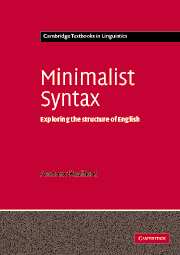9 - Split projections
Published online by Cambridge University Press: 05 June 2012
Summary
Overview
Hitherto, we have assumed a simple model of clause structure in which canonical clauses are CP+TP+VP structures. However, in §5.6 we suggested that it is necessary to ‘split’ TP into two different auxiliary-headed projections in sentences like He may be lying – namely a TP projection headed by the T constituent may and an AUXP projection headed by the AUX constituent be; and in §7.3 we suggested that it may be necessary to posit a further Asp (ect) head in clauses to house the preposed verb in quotative structures like ‘We hate syntax’, said the students. In this chapter, we go on to suggest that CPs, VPs and NPs should likewise be split into multiple projections – hence the title of the chapter. We begin by looking at arguments that the CP layer of clause structure should be split into a number of separate projections: Force Phrase, Topic Phrase, Focus Phrase and Finiteness Phrase. We then go on to explore the possibility of splitting verb phrases into two or more separate projections – an inner core headed by a lexical verb, and an outer shell headed by a light verb (with perhaps an additional projection between the two in transitive verb phrases). Finally we turn to look at evidence for a split projection analysis of NPs.
- Type
- Chapter
- Information
- Minimalist SyntaxExploring the Structure of English, pp. 327 - 380Publisher: Cambridge University PressPrint publication year: 2004



